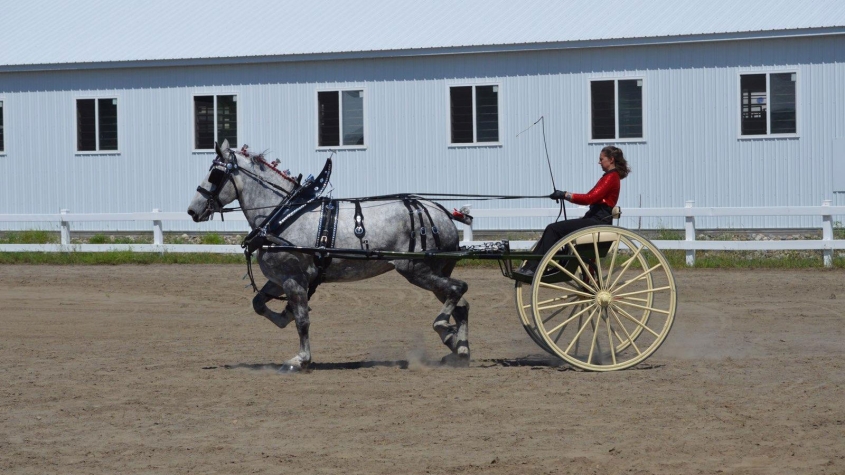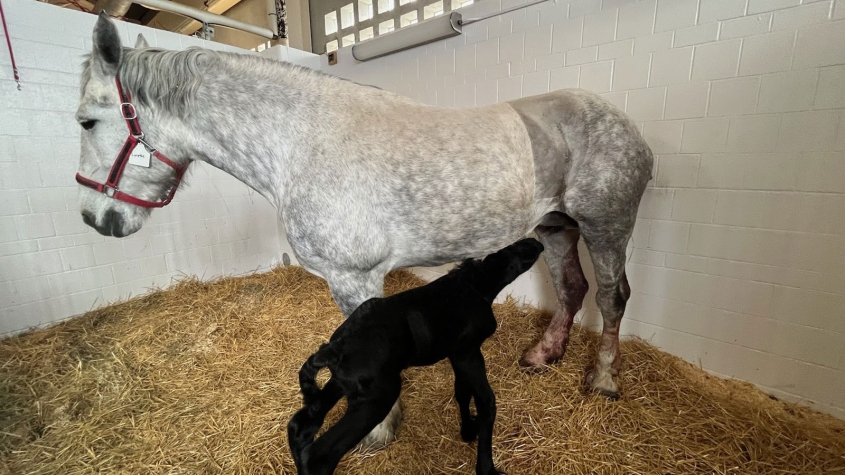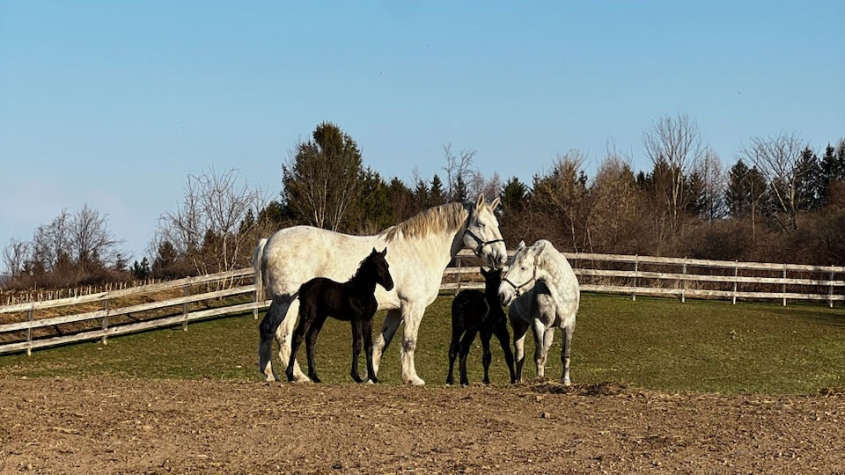Mare survives dire upside-down pregnancy
As Lynnette, a seven-year-old Percheron mare weighing approximately 2,000 pounds, moved into the final weeks of her second pregnancy in March 2023, her owner, Bonnie Marr, noticed that she seemed unusually uncomfortable.
“She didn’t look distressed,” Marr says. “It was more of a subtle thing. I thought she might be having a bit of colic.”
But when the symptoms went on for close to a week, Marr, a physician, began to worry that it might be early labor, and she took Lynnette to her equine veterinarian at the Leatherstocking Equine Center in New Berlin, New York, where they also suspected colic and did an examination. This revealed that the colic wasn’t related to Lynnette’s intestines or colon, but rather involved her uterus.
Somehow, the pregnant uterus had twisted upside-down.
This is called a uterine torsion, which is rare in horses. No one knows for sure what causes them, but they can be fatal. The most obvious problem is that the foal can’t be delivered from the uterus when the time comes because of the blockage, and the twisted blood vessels also become engorged and can rupture, killing both the mare and the foal.
The only way to fix the problem was through surgery, and it needed to be done right away. Fortunately, the Cornell Equine Hospital was less than two hours away, but that night, a late winter snowstorm hit upstate New York just as Marr was preparing to drive Lynnette to Ithaca. Marr was afraid they were headed for even more trouble.
At Cornell, Marr turned Lynnette over to the care of a team of veterinarians: from the surgery service, then-resident Dr. Brenna Pugliese and veterinary surgeon Erica Secor ’08, D.V.M. ’13; and from the reproductive medicine service, resident Dr. Bradley Back and associate professor Soon Hon Cheong, D.V.M. ’12. The team stabilized Lynnette as they evaluated her condition and decided on a treatment plan. The foal, they determined, was alive, but surgery would be necessary as soon as possible.
Initially, they considered doing an emergency c-section, but the reproductive medicine team decided that Lynnette was still too far from her due date and the foal wasn’t ready. Surgery was considered the best option, and since Lynette is so big — Percherons average 16-17 hands high — the safest way to do surgery was a standing approach. Improved standing surgical procedures, along with advances in anesthesia and pain management, avoid laying the big draft horses like Lynette down with general anesthesia, which is important for preventing complications. The anesthesiologists perform a local nerve and/or tissue block at the site of the incision, monitor the intravenous constant drip of anesthetic medications and the vital parameters of the horse, while the surgeon focuses on flipping the uterus back to the correct position.
“We made an incision on either side of the abdomen in the flank region,” says Secor, “and then we tried to rotate the baby and the uterus into the correct position.”
All easier said than done. The foal alone weighed approximately 120 pounds, not counting the placenta, and, as surgery got underway, the veterinarians discovered the foal was very active. “She was kicking like nobody’s business,” says Secor. “She seemed very upset that we woke her.”
It took several hours of lifting and the deployment of every strategy the team members could think of, plus emergency calls to colleagues. In the end, they filled Lynnette’s abdomen with 25 liters of sterile fluid, which made the uterus float. That, and an extra set of arms, finally did the trick. “There were cries of joy when we finally got it back around,” says Secor.
Lynnette, meanwhile, remained calm. “I don’t think she ever moved a foot,” Secor says. “Not many horses would have tolerated that. She’s worth her weight in gold.”
Marr and the surgical team agreed it would be best for Lynnette to remain at Cornell until she foaled. A filly, Lili Marlene, was born two-and-a-half weeks later. It was fortunate Lynnette stayed at Cornell, as Lili had a complicated delivery. She was not in the correct orientation and needed assistance, which the veterinarians at the Cornell Equine Hospital were on hand to provide. Both mare and foal were healthy and able to go home within a couple days.
“I consider myself very fortunate that they both survived,” says Marr.
Now, over a year later, Lynnette is ready to return to the show circuit. Lili Marlene suffered from an issue in her airway, and unfortunately passed away in May 2024 due to a colonic torsion. Neither condition was related to the uterine torsion.
Marr is debating whether to breed Lynnette again. It’s unlikely Lynnette will have to suffer through another uterine torsion, but Secor recommends that owners keep a close eye on their pregnant mares for anything out of the ordinary and to reach out to their veterinarian with any questions or concerns.
Written by Aimee Levitt







